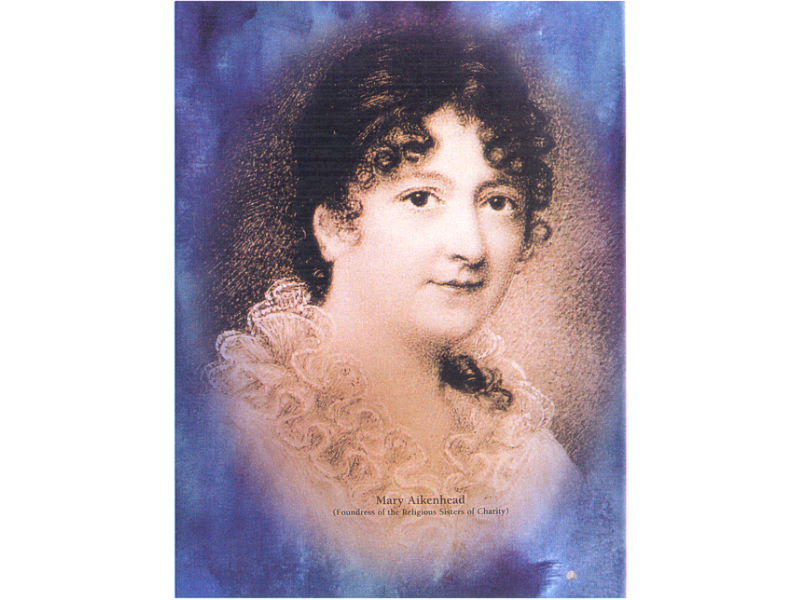
HOPE IN THE LIFE OF MARY AIKENHEAD
Fragile in the Eyes of the World, Strong in God
“Everything that happens only confirms my hope that it is the work of God Himself.”
(March 7, 1834)
The March wind swept through the streets of Dublin, rattling the windows of the houses. It carried with it the acrid smell of chimney smoke and the sharper scent of poverty that weighed on so many families. Carriages and carts rolled through the muddy streets, mixing the noise of wheels with the murmur of the crowd. Ireland was living through uncertain days: peasants, dependent on a fragile harvest, feared every famine; weavers, impoverished by the collapse of the textile industry, sought work elsewhere but found none. In many rural areas anger grew, for even the poorest Catholics were forced to pay taxes to maintain the Anglican Church, and the revolts that followed were brutally suppressed. And yet, in that land marked by hardship and tension, hope still searched for a place to take root.
Mary Aikenhead knew this well. She looked at Ireland with clear eyes and a compassionate heart: the poor were not numbers to her, human faces, outstretched hands, voices asking for dignity. In a time when it seemed impossible to imagine something new, she cherished a dream many considered unattainable: to establish a Catholic hospital, a house of charity open to the sick poor. Not a project of prestige, but a seed to be planted in the soil, small and fragile, entrusted solely to Providence.
On January 23, 1834, the feast of the Espousal of the Virgin Mary and Saint Joseph, that seed was entrusted to history. Mary took possession of a large residence destined to become St. Vincent’s Hospital. The Archbishop celebrated Mass in the dining room, hastily transformed into a chapel: bare walls, the wood of the furniture still smelling of wax, the timid singing of the sisters. There was no grandeur, but a humble and true beginning, like the birth of a child.
Soon, however, the seed was covered by hard soil. Promises of support faded, benefactors withdrew, criticism multiplied. The house was large but empty; funds scarce, suspicions many. Mary felt the weight of an undertaking that seemed destined to collapse before it had even begun. Often she could be found in the bare chapel, in prayer before the tabernacle: the accounts on the table, the projects suspended, but her heart gathered in a silence that became offering.
It was then that something hidden, yet decisive, took place. Three patients were received within those walls, far from the world’s gaze. There were no wards, only rooms adapted as best they could; no equipment, only hands serving with love. But in those improvised beds, among rough blankets and nights kept in vigil, the work truly began. Every simple gesture – a glass of water offered with care, a pillow adjusted, a silent prayer – transformed precariousness into a sign of hope.
The sisters walked among those beds in silence, with a gaze that did not stop at suffering but recognized the very face of Christ. Mary did not seek approval from men, nor wait for official recognition: in those three patients marked by illness she already saw the proof that the seed was sprouting. It was not yet a hospital: it was only the beginning, fragile and hidden, yet safeguarded by God.
The trials were not lacking. The death of friends and benefactors, deaths in the Congregation, her increasingly fragile health that often confined her to rest. Yet precisely when the burden grew heavier, Mary found the strength to entrust everything to the Lord. She did not cling to the works as if they were hers: she handed them over, certain that they belonged to God. And in giving them back, she never ceased to do good, seizing every opportunity Providence offered.
Thus, in a time marked by uncertainty, Mary Aikenhead became a sign of unshakable hope. Her faith was not blind stubbornness but a clear gaze that recognized God’s hand even in adversity. Her hope was not illusion but the certainty that no trial is wasted when lived in Him. Her courage was not clamorous, but daily perseverance, the steadfast calm of one who knows that true strength is born of surrender.
It was in that weaving of hardships and promises that her words took shape, simple and strong as a seal:
“Everything that happens only confirms my hope that it is the work of God Himself.”
And Dublin, with its changing skies and noisy streets, was a silent witness. Within still-bare walls, in a time of uncertainty and fragility, Mary had planted a seed the wind could never carry away: hope, rooted in God, able to withstand every storm.
__________________________________
REFLECTION
Mary Aikenhead’s journey in 1834 shows how faith, when authentic, does not remain hidden in the heart but becomes a source of hope and courage. Fragile in the eyes of the world, Mary found in her trust in God the strength not to be overcome by difficulties. Criticism, financial struggles, failing health: nothing could extinguish her conviction that the Lord was guiding everything.
Pope Francis reminds us that “Holiness is parrhesia: it is boldness, it is an impulse, it is speaking freely, it is missionary fervor” (Gaudete et exsultate, no. 129). In this attitude we recognise Mary: bold not because she sought extraordinary deeds, but because she had the courage never to stop doing good, even when everything seemed fragile and precarious.
And yet the temptation to flee before trials is always present. “Like the prophet Jonah, we too can constantly have the temptation to flee to a safe place…” (Gaudete et exsultate, no. 134). Mary could have protected herself, abandoned the project of the hospital, sought refuge in the security of works already established. She did not: she chose to remain at the heart of the storm, allowing Providence to decide the times and the ways.
Her hope then revealed itself as the virtue of the strong. “The Christian life is a constant battle. It takes strength and courage to withstand the temptations of the devil and to proclaim the Gospel” (Gaudete et exsultate, no. 158). Mary lived this battle without clamour, in daily perseverance, turning crosses into opportunities for surrender and hardships into seeds of love.
Her witness remains alive and radiant. She does not invite us to seek fleeting securities, but to root our lives entirely in God. Not to flee from our fragility, but to recognise it as the very place where grace comes to dwell. It is precisely there, where human strength fails, that God’s power is revealed. Thus faith becomes the certainty that nothing is lost, hope is transformed into an active waiting for fulfilment, and courage becomes a persevering gift, able to open paths of new life for many.
__________________________________
PRAYER
Lord Jesus,
You who chose what is weak to confound the strength of the world,
teach us to live like Mary Aikenhead,
fragile in the eyes of others, yet steadfast in You.
Grant us a faith that does not falter before trials,
a hope that is not extinguished by disappointments,
a humble and persevering courage
that remains faithful even in silence.
Let us not seek human securities,
but root our lives in Your will,
recognizing in fragility the very place
where Your grace is revealed.
Make us instruments of Your love,
so that, like Mary, we may transform suffering into offering,
toil into seeds of new life,
and every day into an opportunity to say with her:
“Everything that happens only confirms my hope that it is the work of God Himself.”
Amen.
Story written Dr Valentina Karakhanian
Postulator for the Cause of Venerable Mary Aikenhead.
Phyllis Behan RSC
Vice-Postulator – collaborator







